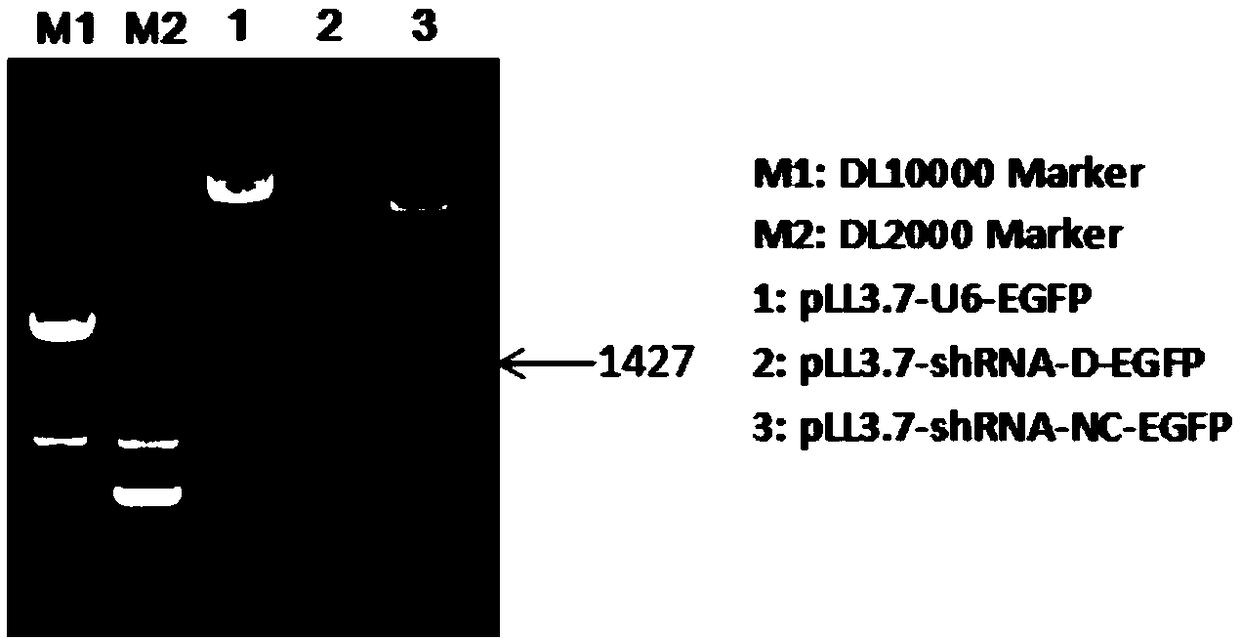Gene HDAC11 interfered chimeric antigen receptor T-cell and application thereof
A chimeric antigen receptor, HDAC11 technology, applied in the field of biomedicine, can solve the problems of killing tumors, exhaustion, and weak CAR-T cells
- Summary
- Abstract
- Description
- Claims
- Application Information
AI Technical Summary
Problems solved by technology
Method used
Image
Examples
Embodiment 1
[0221] Example 1 Construction of pLL3.7-HDAC11-shRNA interference vector
[0222] 1.1 RNAi target sequence design
[0223] Find the gene sequence number of Homo sapiens histone deacetylase 11 (HDAC11) on the NCBI website: NM_024827.3. According to the gene number, the HDAC11 gene RNAi target sequence was designed on the website (https: / / rnaidesigner.thermofisher.com / rnaiexpress / design.do), and the results are shown in Table 1.
[0224] Table 1. HDAC11 Gene RNAi Target Sequences
[0225]
[0226] 1.2 Design the interference sequence according to the target sequence:
[0227] Based on the screened target sequence, the interference sequence is designed and determined according to the following principles: the 5-terminus starts with G, and the G+C content is set at 30%-50%. According to the requirements of the pLL3.7 vector, (1) add T to the 5' end of the sense strand to rebuild the T at the 1 position of the U6 promoter. (2) Add Loop "TTCAAGAGA" after the interference targ...
Embodiment 2
[0235] Example 2 Packaging of pLL3.7-shRNA-(D / NC)-(EGFP / CAR19) lentivirus
[0236] 2.1. Plasmid transfection
[0237] 1) Place the plasmid, PEI, and Opti-MEM medium at room temperature for 5 minutes;
[0238] 2) Take 436 μl of Opti-MEM into a 1.5ml EP tube, add 64 μg PEI, mix well, and let stand at room temperature for 5 minutes;
[0239] 3) Take 12 μg vector plasmid, 8 μg psPA×2, 4 μg pMD2.G, add Opti-MEM to 500 μl, and let stand at room temperature for 5 minutes;
[0240] 4) Add the prepared PEI-Opti-MEM solution into the Opti-MEM containing the plasmid, and let stand at room temperature for 20 minutes;
[0241] 5) Slowly drop 1ml of the DNA / PEI mixture into the 293T Petri dish laid out the day before, mix gently, and incubate in a 37°C incubator for 6-8h or overnight;
[0242] 6) Replace with fresh medium, put into 37°C incubator and continue to incubate.
[0243] 2.2. Virus collection and concentration
[0244] 1) After 48 hours of plasmid transfection, collect the su...
Embodiment 3
[0258] Example 3 pLL3.7-HDAC11-shRNA-EGFP carrier interference verification test
[0259] Inoculate Jurkat T in a 6-well plate, 2×10 per well 6 cells in a total of 9 wells. Divided into 3 groups: no virus infection negative control group, pLL3.7-shRNA-D-EGFP lentivirus interference group and pLL3.7-shRNA-NC-EGFP negative interference group, with 2 wells in each group. Corresponding volumes of virus were added to the two experimental groups according to MOI=10:1, and 10 μg / ml polybrene was added to promote infection. After 10 hours, the cells were collected, centrifuged at 1000 g for 10 minutes, the medium was discarded, and fresh medium was added.
[0260] Cells were harvested 48 hours after lentivirus infection, and the expression efficiency of GFP was detected by flow cytometry, that is, the positive rate of virus infection. Results The infection efficiency of pLL3.7-shRNA-D-EGFP and pLL3.7-shRNA-NC-EGFP on Jurkat cells was close to 100%.
[0261] Three groups of Jurkat ...
PUM
 Login to View More
Login to View More Abstract
Description
Claims
Application Information
 Login to View More
Login to View More - R&D Engineer
- R&D Manager
- IP Professional
- Industry Leading Data Capabilities
- Powerful AI technology
- Patent DNA Extraction
Browse by: Latest US Patents, China's latest patents, Technical Efficacy Thesaurus, Application Domain, Technology Topic, Popular Technical Reports.
© 2024 PatSnap. All rights reserved.Legal|Privacy policy|Modern Slavery Act Transparency Statement|Sitemap|About US| Contact US: help@patsnap.com










